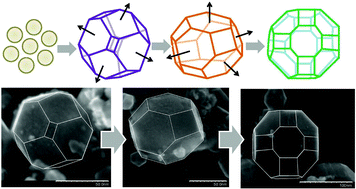Flame synthesis of 26-faceted maghemite polyhedrons grown via 14-faceted polyhedrons and their carbon composites for Li-ion battery application†
Abstract
26-faceted truncated cuboctahedrons of maghemite (γ-Fe2O3)

* Corresponding authors
a
Department of Advanced Materials Chemistry, Korea University, 2511 Sejong-ro, Republic of Korea
E-mail:
jsyu212@korea.ac.kr
Fax: +82-44-860-1331
Tel: +82-44-860-1494
26-faceted truncated cuboctahedrons of maghemite (γ-Fe2O3)

 Please wait while we load your content...
Something went wrong. Try again?
Please wait while we load your content...
Something went wrong. Try again?
S. Inamdar, H. Choi, M. Kim, K. Chaudhari and J. Yu, CrystEngComm, 2012, 14, 7009 DOI: 10.1039/C2CE26146D
To request permission to reproduce material from this article, please go to the Copyright Clearance Center request page.
If you are an author contributing to an RSC publication, you do not need to request permission provided correct acknowledgement is given.
If you are the author of this article, you do not need to request permission to reproduce figures and diagrams provided correct acknowledgement is given. If you want to reproduce the whole article in a third-party publication (excluding your thesis/dissertation for which permission is not required) please go to the Copyright Clearance Center request page.
Read more about how to correctly acknowledge RSC content.
 Fetching data from CrossRef.
Fetching data from CrossRef.
This may take some time to load.
Loading related content
